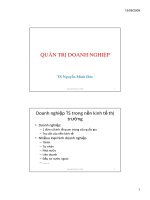Quản trị kinh doanh luôn là một trong những ngành hấp dẫn các bạn trẻ năng động, đặc biệt trong xu thế hội nhập kinh tế Quốc tế của Việt Nam những năm gần đây. Việc tìm hiểu rõ về ngành Quản trị kinh doanh giúp bạn định hướng nghề nghiệp tốt hơn trước kh
Bạn đang xem bản rút gọn của tài liệu. Xem và tải ngay bản đầy đủ của tài liệu tại đây (909.65 KB, 14 trang )
Chapter 3
Contingency Approaches
1
Chapter Objectives
Understand how leadership is often contingent on people
and situations.
Apply Fiedler’s contingency model to key relationships
among leader style, situational favorability, and group task
performance.
Apply Hersey and Blanchard’s situational theory of leader
style to the level of follower readiness.
Explain the path-goal theory of leadership.
Use the Vroom-Jago model to identify the correct amount of
follower participation in specific decision situations.
Know how to use the power of situational variables to
substitute for or neutralize the need for leadership.
2
Ex. 3.1 Comparing the Universalistic
and Contingency Approaches to
Leadership
Universalistic
Approach
Outcomes
Leadership
Traits/behaviors
(Performance, satisfaction,
etc.)
Leader
Contingency
Approach
Followers
Style
Traits
Behavior
Position
Needs
Maturity
Training
Cohesion
Task
Structure
Systems
Env.
Outcomes
(Performance, satisfaction,
etc.)
Situatio
n
3
Contingency Approaches
Contingency approaches:
approaches that seek to delineate the
characteristics of situations and
followers and examine the leadership
styles that can be used effectively
Fiedler’s contingency model: a
model designed to diagnose whether a
leader is task-oriented or relationshiporiented and match leader style to the
situation
4
Ex. 3.2 Metacategories of Leader
Behavior and Four Leader Styles
TASK
BEHAVIOR
High
High Task-Low
Relationship
High Task-High
Relationship
Low Task-Low
Relationship
High
Relationship
-Low Task
Low
Low
RELATIONSHIP BEHAVIOR
High
5
Situational Theory
Hersey and Blanchard’s extension
of the Leadership Grid focusing on
the characteristics of followers as
the important element of the
situation, and consequently, of
determining effective leader
behavior
6
Ex. 3.4 Hersey and Blanchard’s
Situational Theory of Leadership
Follower Characteristics
Appropriate Leader Style
Low readiness level
Telling (high task-low relationship)
Moderate readiness level
Selling (high task-high relationship)
High readiness level
Participating (low task-high rel.)
Very high readiness level
Delegating (low task-low relationship)
7
Path-Goal Theory
A contingency approach to
leadership in which the leader’s
responsibility is to increase
subordinates’ motivation by
clarifying the behaviors necessary
for task accomplishment and
rewards
8
Ex. 3.5 Leader Roles in the PathGoal Model Increase Rewards
Path Clarification
Leader defines what follower
must do to attain work
outcomes
Leader learns follower’s
needs
Leader clarifies follower’s
work role
Leader matches follower’s
needs to rewards if work
outcomes are accomplished
Follower has increased
knowledge & confidence to
accomplish outcomes
Leader increases value of
work outcomes for follower
Follower displays increased effort and
motivation
Organizational work outcomes are
accomplished
9
Ex. 3.6 Path-Goal Situations and
Preferred Leader Behaviors
Situatio
n
Leader Behavior
Impact on Follower
Followers lack
self-confidence
Supportive
Leadership
Ambiguous job
Directive
Leadership
Lack of job
challenge
AchievementOriented
Leadership
Set and strive for
high goals
Participative
Leadership
Clarifies followers’
needs to change
rewards
Incorrect
reward
Outcome
Increases confidence
to achieve work
outcomes
Clarifies path to
reward
Increased
effort;
improved
satisfaction
and
performance
10
The Vroom-Jago Contingency
Model
A contingency model that
focuses on varying degrees of
participative leadership, and how
each level of participation
influences quality and
accountability of decisions
11
Ex. 3.7 Five Leader Decision Styles
Area of Freedom for Group
Area of Influence by Leader
Decide
Consult
Individually
Consult
Group
Facilitate
Delegate
12
Substitute and Neutralizer
Substitute: a situational
variable that makes
leadership unnecessary
or redundant
Neutralizer: a situational
characteristic that
counteracts the leadership
style and prevents the
leader from displaying
certain behaviors
13
Ex. 3.10 Substitutes and
Neutralizers for Leadership
Variable
Task-Oriented
Leadership
PeopleOriented
Leadership
Organizational
variables
Group cohesiveness
Formalization
Inflexibility
Low positional power
Physical separation
Substitutes for
Substitutes for
Neutralizes
Neutralizes
Neutralizes
Substitutes for
No effect on
No effect on
Neutralizes
Neutralizes
Task
characteristics
Highly struct. task
Automatic feedback
Intrinsic satisfaction
Substitutes for
Substitutes for
No effect on
No effect on
No effect on
Substitutes for
Follower
characteristics
Professionalism
Training/experience
Low value of rewards
Substitutes for
Substitutes for
Neutralizes
Substitutes for
No effect on
Neutralizes
14









